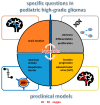Hypoxia Inducible Factors' Signaling in Pediatric High-Grade Gliomas: Role, Modelization and Innovative Targeted Approaches
- PMID: 32326644
- PMCID: PMC7226233
- DOI: 10.3390/cancers12040979
Hypoxia Inducible Factors' Signaling in Pediatric High-Grade Gliomas: Role, Modelization and Innovative Targeted Approaches
Abstract
The brain tumor microenvironment has recently become a major challenge in all pediatric cancers, but especially in brain tumors like high-grade gliomas. Hypoxia is one of the extrinsic tumor features that interacts with tumor cells, but also with the blood-brain barrier and all normal brain cells. It is the result of a dramatic proliferation and expansion of tumor cells that deprive the tissues of oxygen inflow. However, cancer cells, especially tumor stem cells, can endure extreme hypoxic conditions by rescheduling various genes' expression involved in cell proliferation, metabolism and angiogenesis and thus, promote tumor expansion, therapeutic resistance and metabolic adaptation. This cellular adaptation implies Hypoxia-Inducible Factors (HIF), namely HIF-1α and HIF-2α. In pediatric high-grade gliomas (pHGGs), several questions remained open on hypoxia-specific role in normal brain during gliomagenesis and pHGG progression, as well how to model it in preclinical studies and how it might be counteracted with targeted therapies. Therefore, this review aims to gather various data about this key extrinsic tumor factor in pHGGs.
Keywords: HIFs; high-grade gliomas; hypoxia; pediatric.
Conflict of interest statement
The authors declare no conflict of interest.
Figures



References
-
- Ostrom Q.T., de Blank P.M., Kruchko C., Petersen C.M., Liao P., Finlay J.L., Stearns D.S., Wolff J.E., Wolinsky Y., Letterio J.J., et al. Alex’s Lemonade Stand Foundation Infant and Childhood Primary Brain and Central Nervous System Tumors Diagnosed in the United States in 2007–2011. Neuro-Oncol. 2015;16:x1–x36. doi: 10.1093/neuonc/nou327. - DOI - PMC - PubMed
-
- Mackay A., Burford A., Carvalho D., Izquierdo E., Fazal-Salom J., Taylor K.R., Bjerke L., Clarke M., Vinci M., Nandhabalan M., et al. Integrated Molecular Meta-Analysis of 1,000 Pediatric High-Grade and Diffuse Intrinsic Pontine Glioma. Cancer Cell. 2017;32:520–537. doi: 10.1016/j.ccell.2017.08.017. - DOI - PMC - PubMed
-
- El-Khouly F.E., Veldhuijzen van Zanten S.E.M., Santa-Maria Lopez V., Hendrikse N.H., Kaspers G.J.L., Loizos G., Sumerauer D., Nysom K., Pruunsild K., Pentikainen V., et al. Diagnostics and treatment of diffuse intrinsic pontine glioma: Where do we stand? J. Neurooncol. 2019;145:177–184. doi: 10.1007/s11060-019-03287-9. - DOI - PMC - PubMed
-
- Grill J., Massimino M., Bouffet E., Azizi A.A., McCowage G., Cañete A., Saran F., Le Deley M.C., Varlet P., Morgan P.S., et al. Phase II, Open-Label, Randomized, Multicenter Trial (HERBY) of Bevacizumab in Pediatric Patients with Newly Diagnosed High-Grade Glioma. J. Clin. Oncol. 2018;36:951–958. doi: 10.1200/JCO.2017.76.0611. - DOI - PubMed
Publication types
LinkOut - more resources
Full Text Sources

